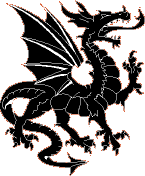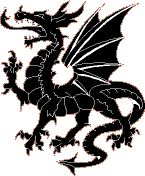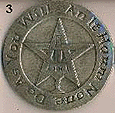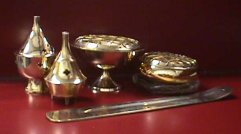 Altars
and Tools
Altars
and Tools
The Heart of Power:
The Altar
 Altars
and Tools
Altars
and Tools
The altar is the place where the Wiccan worships and casts magick. It may be anything as elaborate as an ivory, chiseled table to as simple as your bedroom floor. It is not important what you make your altar out of, it is only important that you take care of constructing it. Remember that your altar is a place of worship and should be treated with respect.Things to keep in mind when selecting an altar:
What type of altar do you prefer? Will you make it, buy it, or use something you already have? Some traditions are specific, round, square, rectangle; personally, I feel you should work with what works best for you.
Where will you place your altar? Inside the house, outside, what room, which corner, etc.? Again, decide what and where works best for you.
What will you use for altar cloths?
(ALTAR CLOTHS: Some Wiccan traditions prescribe a specific color altar cloth for use on the altar. Certain designs [such as pentagrams] may be embroidered or painted onto these cloths. Many traditions, however, don't use them. )What type of illumination will you work by? A good many of us still work only by candlelight or small oil lamps.
What tools & representations of the deities would you like to put on your altar?
Representations of the Deities

The nature of these images are of great variety. Some simply use candles; others natural objects representative of the Goddess & God. Still other Wiccans use hand-crafted sculptors or drawings. Genuine clay is available that, when dried in a normal oven, becomes quite hard. It can be used to create your own interpretations of the Goddess & God.Tools
The tool list below will continue to grow. For now, please enjoy what is here."Never haggle over the price of one's magickal tools" is the rule of thumb, for it is believed that the right tools will come to you at the right time. The most fun in the Craft is the search for these tools which will take you to flea markets, swap shops and antique stores of all kinds. It will often take years to fill in your collection and don't be surprised if your likes change over time. To graciously pass on one's no-longer-wanted magickal tools to another will certainly mean better things will come your way.
There is no defined set of working tools for the Witch. It really depends upon one's specific tradition or his individual tastes and desires. Some traditions will require the full complement of knives, swords, wands, cups, cauldrons, pentacles, etc., while others may require a wooden, hand-crafted wand or simply nothing at all.
Bear in mind one thing about the Witches tools. All of them will be normal things one would find around a house, or in medieval days things one would find around one's cottage. The reason is so that one's tools would be inconspicuous. A broom, one of our magickal tools, might sit idly by in the corner but used secretly during ritual, it might have been used to "cleanse" out an area of any negativity. While rituals and magick were quite common among the aristocracy of the middle ages, it was generally considered devil worship when done by the heathens or common folk. The "Burning Times" is replete with examples of innocent folk killed because it was believed they were communing with the devil.
One universal accepted practice is to thoroughly cleanse and prepare your tools for use. This helps you establish a connection in your brain with the use of the tool for ritual purposes and helps get the negativity off of it so it feels better to work with.
The list of tools below is not a complete list, but represents the great majority of tools you may come across in your studies while on the path.

Book of Shadows
A magickal journal kept by each wiccan initiate, in which spells, invocations, ritual notes, herbal recipes, dreams, divination results and material from the coven book can be recorded. Some people write in Thesbian script or in other alphabets.

Pentacle
A flat disk or plate bearing, at the least, a circle surrounding a five-pointed, upright star (known as a pentagram).which most traditions say is to remain 1 point up, never being inverted.
Each point on the star has a specific meaning: Earth, Air, Fire, Water and Spirit.

The Athame
Of all the tools of the Witch, the athame is probably the most well known.The athame, magickal knife, is most often used to create and disperse circles of "sacred space" inside which, the Witch or magickian performs his rituals. But there are those of other traditions who use it for other purposes. Wiccans will use the athame primarily to cast or banish a magick circle, to direct energy for magickal purposes during a ritual, to bless the cakes and wine following a ceremony. Those of other traditions, including ceremonial magick, will use the athame to invoke and control demons, elementals and other spirit entities. This is generally NOT done within Wicca. However, there are Wiccans who simultaneously follow other magickal paths.
An athame is traditionally a black-handled knife, but in practice can be made of any kind of wood, animal horn, gold, silver, metal or even made entirely of crystals and semi-precious gemstones. As with all magickal tools, it is cleansed and purified before use and one's athame is never actually used for cutting anything, save one's handfasting cake. To forge or craft one's own athame is one of the most rewarding experiences in obtaining one's tools.

The Sword
The sword is used for basically the same purpose as the athame. Some traditions will require that a coven or working group have its own coven or group sword, whereas other individuals might have their own individual sword. Swords come in all shapes and sizes and as the athame, are made of all types of materials. Swords can easily be the most expensive of the working tools depending upon the type.

The Wand
The wand is another "traditional" tool of the Craft.I have seen beautiful hand-crafted wooden wands as well as those made entirely of crystals and even those made of many different materials. A traditional length for the wand is the length from the crook of your elbow to the end of the middle finger on your hand. Really, whatever feels best for you is what is best. Again, certain traditions will have certain requirements and a handmade tool is always preferable over a purchased one.

The Broom
Cleanse the ritual area with the broom before rituals. Some witches name theirs. Can he fashioned from an Ash staff, Birch twigs and a Willow binding. Brush the broom with Chamomile, willow, Lemon Balm, Elder or Mallow stalks and branches, then bury these with due solemnity. Carve a crescent Moon upon it's handle if you wish.

The Staff
The staff is mostly used like a wand. The staff can be used to cast magickal circles much like the athame and sword. I have seen some wonderfully hand-carved and decorated staffs (staves) made of many different materials. They are typically made of wood, however, never kill a tree to make a staff and try not to buy a staff made out of rainforest wood like teak.

The Boline
Also sometimes less-commonly called a "White Handled Knife," the boline is traditionally used for cutting and working with herbs. Some bolines are beautiful crescent shaped blades about 4 inches in diameter and larger,while others are simply knives of different shapes and sizes.For those who follow the use of herbs strictly, every herb has its primary time of harvesting, whether it be a certain hour of day during a certain moon phase or simply during the morning time when a flowering herb has just opened. Cutting herbs to these folks is not like picking up a pile of vegetables in a supermarket. To them it is a ritual all in itself deserving of one's attention to detail as well as the use of this special tool. Harvesting herbs is a magickal ritual in itself and a bonding to the inherent energies of the earth and the plant one seeks.

Bell
A consecrated brass or crystal bell is often used by Witches to signal the beginning and/or close of a ritual or Sabbat, to summon a particular spirit or deity, and to awaken meditating coven members. Bells are also rung at many Wiccan funeral rites to bless the soul of the Witch who has crossed over to the realm of the dead.

Incense Burner
In it, incense or herbs are burned to invite the presence of the Goodess and God, and to cleanse the ritual space.

The Cauldron
Ah, the cauldron...probably the most well known of all the Witche's tools. Cauldron's were quite commonplace in medieval history, being used for everything from cooking meals to dying clothes. In modern Witchcraft we have made an association of the cauldron with the Goddess. We use the cauldron in our rituals to make cider, to hold our small fires (inside), and to even be a safe place to let a candle burn down so we don't have to worry about an unattended candle falling over and setting our house on fire.During certain rituals, the cauldron represent fertility and when jumped over it is believed to help one become more fertile. Cauldrons are used for many purposes and come in all shapes and sizes. The most traditional is the 3 legged black cast iron cauldrons that are available in many magickal supply houses. They come in sizes from about as big as your fist to about 3 feet in diameter or even larger.

The Chalice
The chalice is partially another cauldron, but in different form. Chalices are one of the most elaborate of the tools you will find depending on how it was made and what materials are used. I have seen some beautiful silver work and work with silver solder on crystal and some wonderful hand thrown pottery chalices. One warning though about chalices. If you buy a brass chalice, make sure that the inside of the cup part is coated with silver or some other material. When wine makes contact with brass, the wine turns poisonous!